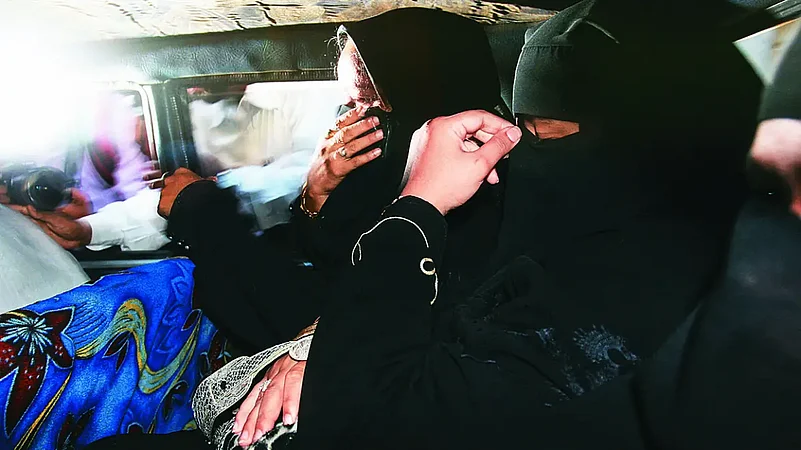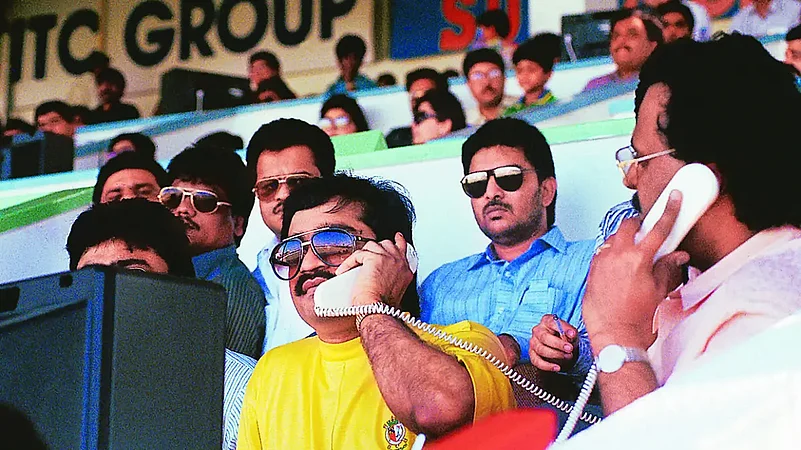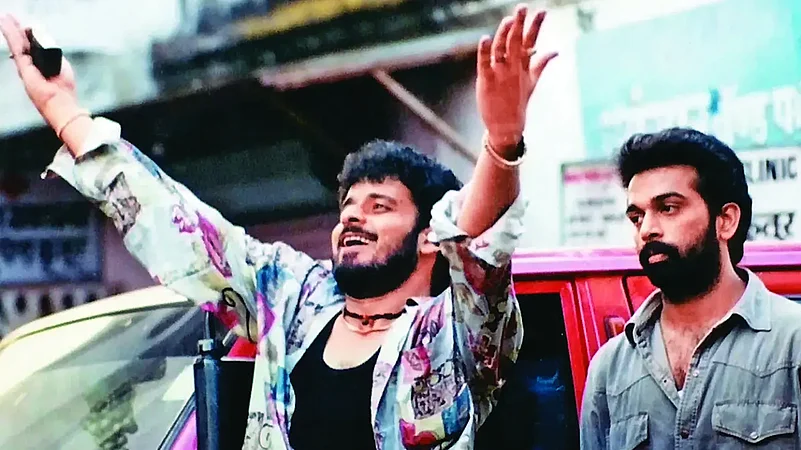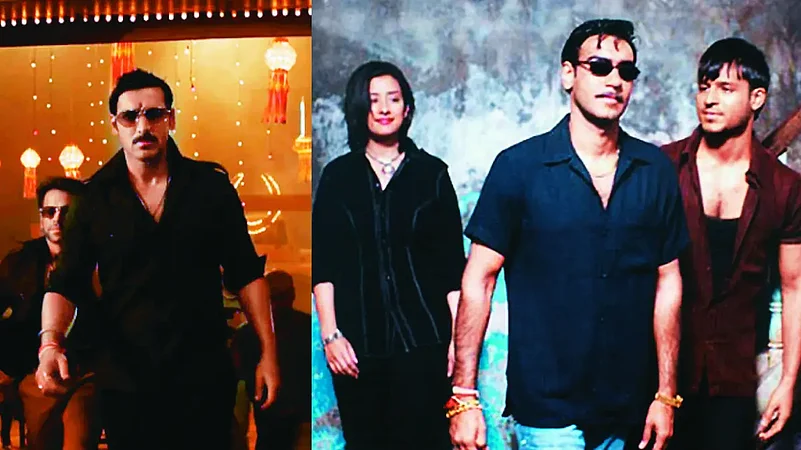The man I met to discuss Mumbai’s dark, seamy side was seated in a room bathed in natural light. Light streamed in from a half-window, which ran across a wall and looked down at the smaller, dilapidated houses below.
The faded sofa at one corner had seen better days. It must have been sea green when it was new. Two chairs that matched the fatigued sofa sat alongside. A showcase nearby was decorated with dolls and miniature paintings of waterfalls. There was a TV set and a centre table. The bare, pearl white walls had graffiti on some corners, most likely scribbled by a child, and a “railway-station type” big wall clock. The home bore most signs of a family residence. The man of the house, who was speaking to me, was a former gangster who had served jail time and was trying to get his life back on track.
“I regret everything I have done,” is his opening line.
Reaching this short, squat man with a thick moustache and a scar on the back of a hand was not easy. My contact took the congested, often dirty lanes somewhere in Byculla’s chaos to bring me here. The working class neighbourhood was a maze, with shades of poverty and a touch of middle class affluence.
The moment I entered the room, the man—who asked to be called Bhai—asked for my cellphone. He checked it and asked me to switch it off. Only then did he start telling his story—his past, present and other details of Mumbai’s underworld.
“I wanted to be a gangster and became one. Today, I only have regrets. No one trusts me enough to give me a job,” he tells Outlook. “More than anyone else, it is politicians who have used us. Bahut nakaab khulega agar humne mooh khola toh (Many masks will fall off if I start talking). I’m sitting in this room with no work and no income. What do people like us do?” he says, after a little prodding.
He appears hapless about the drastic change in his fortunes. In their heydays, that wouldn’t be a word you would associate with the underworld, as they chased and often wrested others’ fortunes by physical force, or just a phone call.
Phone or gun
Between the 1970s and the 1990s, a simple telephone call could evoke as much fear as a gun held to the temple of Mumbai’s moneybags. If they ignored it, they knew the gun would find them, sooner or later. Once you answered the call, the choices were simple. Either you negotiated a deal and paid up the money demanded to stay alive, or you were shot dead.
Fruit juice seller-turned T-Series audio mogul Gulshan Kumar was killed outside a temple; a Mumbai jeweller was shot and stabbed inside his home; while sari shop owner Bharat Kumar was gunned down outside his store. Death for Mumbai’s businessmen could lay in wait anywhere. There was no pattern, other than the traces of hot lead searing the skin.
The year Gulshan Kumar was shot dead was also the year Bollywood filmmaker Rajiv Rai dodged death, which rode bullets allegedly fired by gangster Abu Salem’s henchmen in Tardeo in south Mumbai. Rai was still an exception to the wave of extortion demands and deaths that threatened to drown the city’s rich.
Bombay was gripped in a fear psychosis as kidnappings, murders and shootings ruled the headlines. The change of the city’s name from Bombay to Mumbai could do little, other than divert attention from the crime wave.

Triangular nexus
The streets were bloodied with inter-gang wars, and the wealthy did all they could to cover their tracks by exhibiting financial modesty. While there was blood on the streets, at the very top, there appeared to be a sense of bonhomie between the leading lights of the underworld-politician-police network.
The nexus between the three pillars of Mumbai’s netherworld had wreaked havoc with the city’s law and order. Gangster threats were not reported to police because those who received the threats believed Mumbai’s gangsters keep their word more than the cops would. There were enough dead bodies on Mumbai’s streets to prove it.
Blasts and the encounter raj
It was only after an unprecedented wave of bomb blasts that the city’s police and political establishment finally cracked down on organised crime orchestrated by the underworld. In 1993, 12 bombs, engineered by fugitive don Dawood Ibrahim and executed by his henchmen, exploded across the city that had just begun to return to normalcy after a month-long communal riot that followed the Babri Masjid demolition in Ayodhya.

The blasts were a response to the mosque demolition. The ingredients for the bombs had been smuggled into the city using the same route and hideouts the underworld used to smuggle contraband. Mumbai Police, which had been accused in the past of being in cahoots with the underworld, was jolted out of its complacency. Their jackboots were out on the streets again, and they began to use their service pistols liberally, hitting back at gangsters with vigour.
The Mumbai Police Detection Squad provided the best talent to recruit an encounter team. It was the turn of encounter specialists Daya Nayak, Praful Bhosale, Pradeep Sharma, Vijay Salaskar, Sanjay Kadam, Sachin Vaze and Aslam Momin to unleash terror on the mafia, decimating the gangs.
Two decades hence, their bullets have accounted for nearly 900 alleged extra-judicial executions. The bloodbath virtually decimated gang activity on the streets. Scared by the encounters, several gangsters started surrendering to the police.
Incidentally, the first ever encounter killing by Mumbai Police took place on January 11, 1982, when cops gunned down dreaded dacoit Manya Surve at Wadala.

Blood red to white collar
The decade since 2010 saw a perceptible shift in the way the underworld conducts business. It got into economics, eschewing guns. The economy, a source tells Outlook, was not conducive for over-the-top gangster histrionics. Moreover, joining an underworld gang was simply not considered glamourous anymore, because it not only meant getting one’s name scrawled on a death warrant, but also years in jail without bail, as well as a long trial, what with the government deciding to apply stringent provisions of the MCOCA (Maharashtra Control of Organised Crime Act) against gangsters and criminals.
Instead, the underworld found a simpler, more sophisticated method of income generation. They simply switched to running bank frauds and cyber crime rackets. “Most illegal activities are now carried out in partnership with a ‘frontman’, who is either a businessman, builder or politician,” says a source, familiar with the Mumbai’s paatallok. Like in the case of former minister and NCP leader Nawab Malik, who is currently in Enforcement Directorate custody and is being probed for his alleged links with the Dawood Ibrahim gang.
The source tells Outlook that the government’s slum redevelopment projects had engendered a newer nexus of the underworld, builders, politicians, bureaucracy and police. “Gangs are now hired by builders to secure areas they are eyeing for redevelopment. Residents who resist the redevelopment plan and refuse to move are threatened, while anyone lacking all residence proofs is driven away. The profits get shared among them,” says the source. Gangster Chhota Rajan’s wife Sujata Nikhalje’s name, for example, has cropped up in connection with slum redevelopment schemes in the Chembur area, which was once Rajan’s stronghold.
Gentleman dons
The origins of serious crime in the city, then known as Bombay, can be traced to the 1940s. The underworld was still in its infancy, finding its feet in the city they would soon rule. Their activity was sporadic, with little elements of organised crime. But the criminals had begun flexing muscles, slowly and forcefully staking their claim on the city’s wealth.
That wave escalated in the 1950s, as nondescript gangsters grew in stature and tried to carve their own territories in the young city. In the ’60s, three gangsters, Abdul Karim Sher Khan alias Karim Lala, Haji Mastan Mirza alias Haji Mastan and Vardarajan Mudaliar, rose to the top of the criminal world. Thus began the age of consolidation.

Their rise was intrinsically linked to the government’s License Raj policies. Anything the government banned, the gangsters would stealthily smuggle over the Arabian Sea. Contraband on their radar included liquor, foreign luxury electronic goods, gold and silver. Mastan, Mudaliar and Lala operated their own smuggling rings and thrived. They smuggled gold and silver ingots, perfumes, liquor, radios and other electronic items, and sold them on the sly, at a very high premium. Smuggling became the financial backbone of the underworld.
Police sources tell Outlook that Lala, Mastan and Mudaliar built their gangland empires on trust and mutual respect. Lala’s rise to the top of the underworld was on account of his grip on extortion, as well as gold and silver smuggling backed by a network of gambling and liquor dens. Meanwhile, Mastan’s sartorial style of white designer clothes with an imported cigarette hanging from his lips became a Bollywood cliché. His obsession with a Bollywood actress who hailed from the South was stuff of legends. An ardent fan, Mastan watched all her films several times, attempting to boost ticket sales hoping it would convert the films into hits, say police sources.
Born in Cuddalore, on the Bay of Bengal coast in Tamil Nadu, Mudaliar ruled the waves of the Arabian Sea off Mumbai. When he arrived in Maximum City, he could speak only in Tamil, but he quickly picked up Hindi in prison after he was arrested under the Conservation of Foreign Exchange and Prevention of Smuggling Activities Act. He only lost control of his empire when his nephew Samad took over.
The crime primer
In Mumbai’s mafia ke pathshala, a newcomer progressed through its various grade schools: the toli and company, finally making it to the white business company. The toli comprised of street muscle run by a local goon (dada), who oversaw petty extortion rackets, gambling, illicit liquor dens, land grab operations and black marketing of cinema tickets.
Chhota Rajan himself rose from a film ticket black marketeer—a trade that disappeared after multiplexes replaced single-screen theatres, and OTT streaming came into its own. In old times, black marketing of film tickets was a means by which local tolis established control over an area.
While in the 1960s-70s, Lala, Mastan and Mudaliar came into their own with the smuggling of gold, imported electronic and luxury goods, cannabis and cocaine, over the next two decades, they diversified into businesses as they tried to cover up their blood-soaked pasts under white collar jackets.
They set up their organised crime syndicates known as companies and diversified into construction, film production and share trading, though large-scale extortion rackets, contract (supari) killing and land grab remained their stock-in-trade as they brought in the bulk of the moolah. This was then invested in their ‘legal’ businesses to convert black money into white.
Liberalisation and the underworld
The ’90s liberalisation, when India and Indians woke up to a new, liberalised economic order, was a period of fear for Mumbai’s businessmen. Economic “reforms” promoting globalisation and liberalisation introduced by then PM P.V. Narasimha Rao and his Finance Minister Manmohan Singh in 1991 saw the Indian market flooded with foreign goods. It hit smuggling—till then the backbone of the underworld—hard. Suddenly, luxury and electronic goods were legally available in bulk and within reach of the common man.
Long before that, liquor prohibition laws had been diluted after Maharashtra was separated from Gujarat in 1960, and liquor became legally available in Bombay. It ended another source of income of the mafia. That was when gangs tried to reinvent themselves.

Desperate to find newer sources of income, the bigger gangs turned to extorting the rich and powerful, including real estate developers, Bollywood stars, businessmen, financiers, etc. The 2000’s recession also taught the gangs a lesson in manpower management. There simply weren’t enough targets to extort from, making it difficult to maintain and upkeep a large gang on salaries. So, as Nehruvian socialism gave way to neo-liberal contractual employment, dons started using ‘extortion agents’ for a fee on a ‘project’ basis. These freelancers would call up the targets, demand extortion money and follow up until it was delivered, says a source.
Two hit Bollywood films on the underworld—Satya and Company—document the manic period, when gangsters acted as a parallel ‘tax’ collection system, where default did not attract a notice, but the crack of a bullet.
Splinter groups
After a decade of bloodshed that included the police counter-offensive that followed the 1993 Bombay blasts, the fabric and temperament of Mumbai’s underworld began to change. Ruthless dons like Dawood, Samad, Amirzada Pathan, Arun Gawli, Amar Naik and Chhota Rajan replaced the patriarchs of yore—Mastan, Lala and Mudaliar. With them, went the “ethical” observance of territorial boundaries. It was now open season.
Inter-gang battles got bloodier with the killing of Shabir Ibrahim Kaskar in February 1981 by the Pathan gang, which was now run by Lala’s sons Samad and Amirzada Khan.
Dawood’s brother Kaskar was shot dead point-blank at a petrol pump opposite Dadar’s Siddhivinayak temple by four men. His bullet-riddled body initiated a bloody, two-decade-long gangland war on Mumbai streets.
To avenge his brother’s killing, Dawood swore to eliminate all members of the Pathan gang, originally started by Lala. In September 1983, Dawood responded. One of Kaskar’s killers, Amirzada Khan, was killed outside the Mumbai sessions court. Samad Khan, another killer, was shot dead in a restaurant in south Mumbai in 1984.
The turn of the millennium also witnessed a new mutation in gang culture. The old order, in which a few dons held sway over large monolithic organisations, gave way to smaller, leaner and hungrier gangs, who split from the old companies. While Lala, Mastan and Mudaliar had a reputation of being ‘sophisticated’, the trademarks of outfits led by Dawood, Gawli, Pathan and Naik were ruthlessness and a lack of respect for territorial boundaries.
It was Dawood in the 1970s who added an even more violent streak to the already bloody universe of crime in Mumbai. Though he fled India in 1986, he continues to operate through his associates, known as the ‘D Company’. From street-side, city-centric affairs, the dons became international wheeler-dealers, for whom networking is as important as a glock. With focus on business partnership deals and manipulation of laws through politicians, they shed their reliance on muscle power.
The genesis of the nexus
The criminal-police nexus in Mumbai dates back to the 1940s, when the underworld started a parallel economy in Mumbai and Gujarat, and smuggling went on unhindered. Smugglers paid cops hafta (protection money), who began to corner huge amounts of ill-gotten wealth. Soon, politicians who controlled the police force became the third axis of this nexus.
According to police sources, the underworld dons provided an ‘assured income’ and ‘assured votes’ from their territories. “The underworld developed a support system and provided cash to politicians contesting polls,” says the source.
The criminal-politician nexus continues till this day, as several politicians still invest their illegal earnings in real estate. Across Mumbai and its suburbs, many builders are frontmen for politicians, who give contracts to the underworld to clear the area. Politicians also give mega loans to developers in search of hard cash, and then fall back upon the underworld to recover the dues.
Hindu gangs, Muslim gangs
Until the 1990s, Mumbai’s gangs were not divided along religious lines. But amid the rising religious animosity in the city following the March 1993 bomb blasts, they too split on communal lines, right down to the rank and file.
Dawood’s right hand, Chhota Rajan, dissociated from D Company and set up his own criminal outfit. After Dawood— who fled abroad in 1986 and was the mastermind behind the 1993 blasts—got designated as a ‘terrorist’, a strong anti-underworld sentiment merged, and the police and politicians—thus far beneficiaries of the existing system—did a volte-face and pressed hard against the gangs.
Bollywood filmmakers and writers—constantly on the lookout for new stories—followed these developments closely. Soon, biopics with barely masked identities began to flood the screens, with publicity-hungry dons themselves starting to finance some of these, besides dating filmstars. No wonder that Mumbai’s underworld has become a recurring theme, with Dayavaan (1988), Black Friday (2007), Once Upon A Time In Mumbai (2010) and Shootout at Wadala (2013), joining the long list of Bollywood films glorifying gangsters or encounter cops. For once, art is imitating life, even though sometimes with a gun pointed at the temple.
(This story appeared in print as 'I Am MumBhai')
















